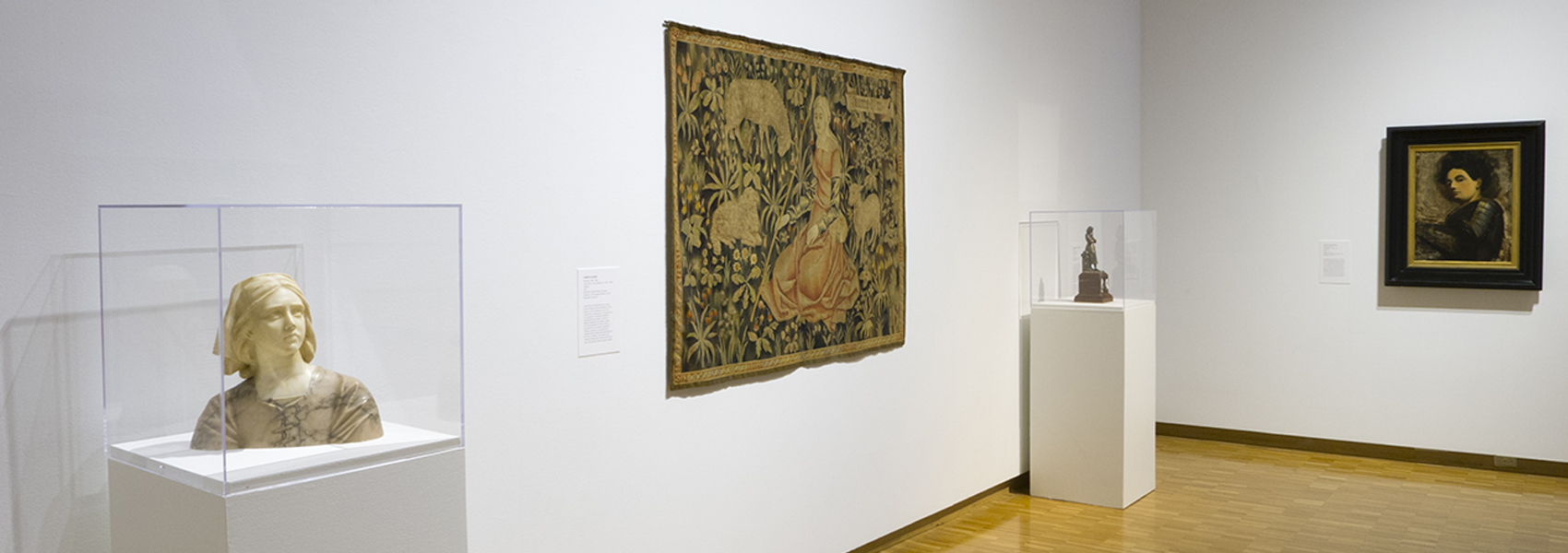Exhibitions at the Haggerty Museum of Art advance the Museum’s mission to enrich the intellectual and creative lives of Marquette University students, faculty and the community at large through transformational, thought-provoking experiences. Exhibitions present an important opportunity to interpret the Museum’s diverse collection from multiple perspectives, and to initiate and share new scholarship related to the Museum's collection. Exhibitions create a forum for critical inquiry, promoting visual thinking, and advancing knowledge across the academic disciplines.
As a general policy, the Museum does not accept unsolicited artist submissions. We cannot guarantee that material e-mailed or sent by mail will be viewed or returned, so we kindly ask that you refrain from submitting unsolicited materials. The Museum’s exhibition schedule is planned several years in advance and is carefully balanced to present varied artistic programming to our audiences. Therefore, we are not able to accommodate unsolicited submissions for exhibitions.
Guiding Principles
- Artistic Excellence - Exhibitions at the Haggerty Museum of Art are comprised of significant works of art that demonstrate a high level of aesthetic quality. Artistic excellence, artistic significance and artistic merit are the primary criteria guiding the selection and evaluation of the Museum’s exhibitions.
- Marquette University Vision, Mission and Values - The Haggerty Museum of Art’s exhibitions support and advance the University’s Jesuit vision, mission and guiding values.
- Audience - Exhibitions at the Haggerty focus on clearly defined audiences. Each exhibition takes into consideration the Museum’s strategic goals for audience cultivation, is aligned with those goals when possible, and is informed by research documenting the needs and interests of the exhibition’s target audience(s).
- Curriculum Connections - Exhibitions presented during the academic year (fall and spring semesters) focus on strengthening teaching and learning in Marquette University courses. Exhibitions presented during the academic year are aligned with outcomes in Marquette’s Core of Common Studies.
- Faculty Partnerships - The Haggerty strives to develop meaningful partnerships with Marquette University faculty members. Towards that end, the Museum regularly invites faculty members to guest curate exhibitions pertaining to their research interests or areas of specialty.
- Community Engagement - The Museum’s exhibitions strive to engage the greater Milwaukee community with the Haggerty Museum of Art. The Haggerty’s exhibitions foster and are shaped by community collaborations whenever possible, in the form of both collaborating institutions contributing content to the exhibition and educational programs developed in collaboration with organizations serving the exhibition’s targeted audiences. The Museum strives, when appropriate, to integrate exhibitions into campus or city-wide thematic programming.
- Local artists - The Haggerty Museum of Art’s exhibition program includes a commitment to exhibit and interpret the work of both established and upcoming artists living and/or working in the greater Milwaukee area.
- Single Collector Exhibitions - The Haggerty Museum of Art does not present exhibitions comprised solely of work lent by a single private collector, unless the collection is an actual or promised gift to the Haggerty.
- Learning - A strong interpretive element is integrated into the design of all exhibitions. Whenever possible, interpretive elements are interactive and/or multi-sensory. Educational programs aligned with the exhibition’s target audience(s) are presented in conjunction with exhibitions. The Museum strives to offer some type of educational publication (gallery guide, catalogue, etc.) with exhibitions. When possible and appropriate, educational resources and programs weave a common thread between exhibitions simultaneously on view in the Museum.
- Planning - The Haggerty generally plans exhibitions two to three years in advance. However, the Museum builds flexibility into its schedule so that the Haggerty may be nimble and responsive to contemporary concerns and/or or unforeseen opportunities. Exhibitions on view at the same time are linked thematically when possible and appropriate.
- Evaluation - Each exhibition is informed by clearly articulated curatorial goals and learning outcomes, and those goals and outcomes are measured with appropriate evaluation protocols.
- Social Concerns - The Museum’s exhibition portfolio includes exhibitions relating to contemporary local, regional, national and international social concerns.
- Balance - The Museum presents a balanced portfolio of exhibitions, demonstrating diversity in audiences served, artists represented (local, regional, national, gender, ethnicity, contemporary, historic) and types of exhibitions (traveling, Museum-originated, collection-based, juried, etc.). The Museum balances thematic group exhibitions with exhibitions of work by a single artist.
- Documentation - Each exhibition is visually documented, and that documentation – along with educational materials produced for the exhibition – is preserved in an exhibition archive that is accessible to Museum audiences.
- Design - Each exhibition integrates high-quality exhibition design that is visually pleasing, that effectively communicates the exhibition’s message, and that facilitates meaningful aesthetic experiences for all Museum visitors.


